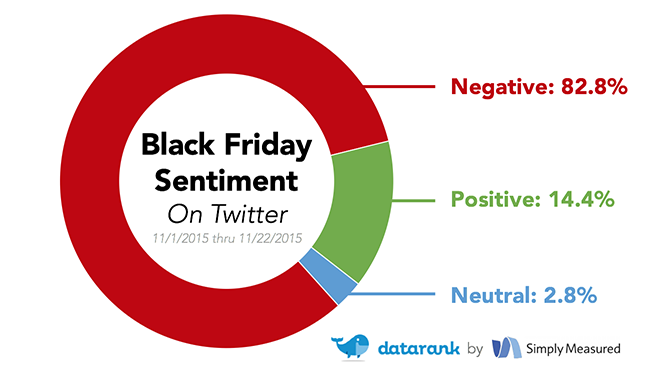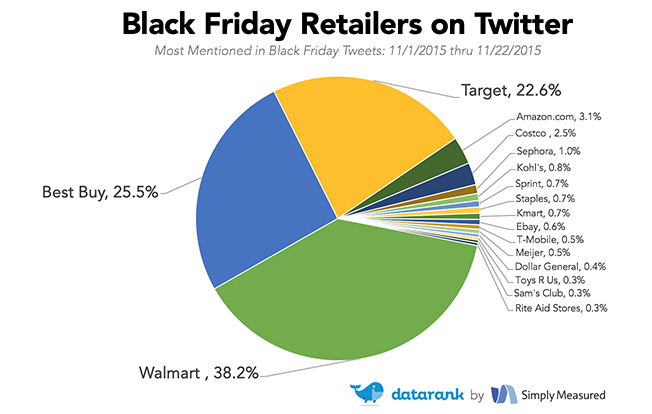With the holiday season upon us with Black Friday right around the corner, it’s time to super-charge your email marketing strategy.
The holiday season represents a huge opportunity for marketers to connect with their audiences and drive sales. Holiday sales in 2015 are expected to represent approximately 19 percent of the retail industry’s annual sales of $3.2 trillion. Additionally, the National Retail Federation is forecasting online sales to increase between 6 and 8 percent to as much as $105 billion.
To help you make the most of it, here are 10 tips that will make your email marketing results merrier:
1. Mark Your Calendar
Email marketing is a highly effective method to reach people this holiday season. With 57% of email subscribers spending 10-60 minutes browsing marketing emails during the week, you’re likely to reach people no matter where they are. Here are this season’s most notable holidays to plan your email campaigns around:
Veterans Day – Wednesday, November 11
Thanksgiving – Thursday, November 26
Black Friday – Friday, November 27
Small Business Saturday – Saturday, November 28
Cyber Monday – Monday, November 30
Hanukkah – Begins Sunday, December 6
Green Monday – Monday, December 14
Free Shipping Day – Friday, December 18
Winter Solstice – Tuesday, December 22
Christmas Eve – Thursday, December 24
Christmas Day- Friday, December 25
Boxing Day – Saturday, December 26
Kwanzaa – Begins Saturday, December 26
New Year’s Eve – Thursday, December 31
New Year’s Day – Friday, January 1
2. Use Progressive Profiling To Send Segmented Offers
Predictive intelligence and individualized recommendations are great, but during the holiday season, your subscribers’ historical data (even very recent data) may not be very helpful because they’re shopping for others more than themselves. Rather than using data to make guesses, it can be more effective to just ask your subscribers what kinds of products they’re interested in.
For instance, on Nov. 13, 2013, Zulily sent a progressive profiling email that resulted in a brand alert email being triggered on Thanksgiving Day. And on Nov. 5, 2014, Sony sent a progressive profiling email where respondents received a targeted triggered email on Black Friday.
In both cases, that’s great timing for an email that the recipient is already primed to act on.
3. Add Seasonal Content To Your Triggered Emails
Triggered emails are not “set it and forget it,” they are “review and renew.” That’s especially true going into the holiday season.
Make your triggered emails more relevant to holiday shoppers by adding seasonal imagery to the headers and gift services footers to the bottom of those emails, and adjust the logic and timing of your cart and browse abandonment emails. For instance, time to purchase is compressed during big shopping days like Black Friday, Cyber Monday and Green Monday, so you’ll likely want to fire off your abandonment emails more quickly than usual.
4. Use Preview Text To Support Your Subject Lines
This is a quick win for the holiday season. Preview or snippet text is displayed under or to the right of the subject line in the inbox view of many major email clients, including the native iPhone email app, Gmail and Yahoo Mail.
Last November, only 47 percent of B2C marketers were optimizing their preview text so that it supported their subject lines. Anecdotally, it’s only slightly higher today.
Think of preview text as a second subject line — and you wouldn’t dream of having long URLs, administrative text and other nonsense filling up your subject line. Whether you use visible or hidden preheader text to create your preview text, don’t leave it to chance.
5. Use Social Media For Aspirational Discovery, And Site Search And Purchase Data For More Practical Discovery
Social media sites like Pinterest can tell you what people aspire to buy from you, and that information can be super-useful in getting your subscribers excited about the holiday season and thinking about the possibilities. That’s especially true early in the holiday season.
But what’s actually happening on your site and in your stores, regarding the products that your customers are buying or actively considering, can be much more telling and worthy of focus.
Consider using this information in your email campaigns more as we get further into the season, when the wisdom of the crowd can be a powerful tool to direct shoppers to your most popular products.
6. Resist The Urge To Email Chronically Inactive Subscribers
It can be oh-so-tempting to want to get a little holiday boost by emailing a bunch of your subscribers who haven’t engaged with your emails in a long time, but resist the urge. The vast, vast majority of subscribers who haven’t engaged in more than two years are likely long gone, with a good chunk of those having abandoned or changed their email address.
Email a bunch of those folks during the holiday season, and you risk getting junked or blocked — which means that you risked your ability to reach your loyal, engaged subscribers for a shot at re-engaging a tiny percentage of inactive subscribers. Not a good bet.
For a smarter, less risky bet, try to identify the seasonal shoppers among your subscribers, those who were engaged and purchased during the holiday season but then quickly became silent afterward and haven’t engaged since. Those subscribers are much better candidates for re-engagement efforts going into Thanksgiving week.
7. Merry Mobile-Friendly Emails
Lastly, and perhaps most important, is ensuring your emails are mobile-friendly. It’s no surprise that prior to (and during) holiday shopping trips, consumers are looking to their mobile devices for the top email offers in their inboxes. Data points in this direction, with internal analytics showing that 50-70% of merchants’ marketing emails are being read on a mobile or tablet device. Coupled with Goldman Sachs’ forecast that mobile commerce will jump to $626 billion in 2018, proves the importance of meshing mobile and email.
Note that 65 percent of all email in the US is now opened first on a mobile device. Take advantage of this device segmenting by sending email offers with key words such as “[fusion_builder_container hundred_percent=”yes” overflow=”visible”][fusion_builder_row][fusion_builder_column type=”1_1″ background_position=”left top” background_color=”” border_size=”” border_color=”” border_style=”solid” spacing=”yes” background_image=”” background_repeat=”no-repeat” padding=”” margin_top=”0px” margin_bottom=”0px” class=”” id=”” animation_type=”” animation_speed=”0.3″ animation_direction=”left” hide_on_mobile=”no” center_content=”no” min_height=”none”][INSERT HOLIDAY] SALE!” or “[INSERT HOLIDAY] – 30% Off Online Only!” Phrases such as “Early-Bird Special” or “24 Hour Sale” work well too.
Keeping mobile top of mind will improve your lead generation and customer acquisition numbers.
8. Have A Plan For Last Sleigh Day
Because Christmas falls on a Friday this time around, express shipping is likely to play a bigger role in the final days of the holiday season. Last Sleigh Day, which is Dec. 22 this year, marks the last chance for guaranteed Christmas delivery with express shipping for most retailers.
After you wrap up your Cyber Week promotions, be sure to include your order-by deadlines for standard shipping and express shipping in a module at the bottom of your emails. And if your brand is going to offer discounted or free express shipping going into Last Sleigh Day, be sure to communicate that to your subscribers.
For more expert advice on how to captivate your customers this holiday season, contact an Onimod Global Digital Marketing expert today.
[/fusion_builder_column][/fusion_builder_row][/fusion_builder_container]





